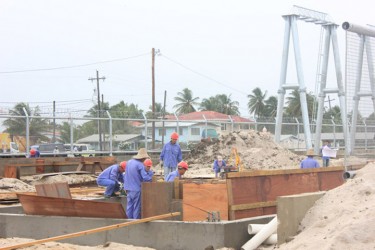The revelation last month that foreign workers were being used to construct a sub-station at Good Hope, on the East Coast Demerara, which is part of a huge project being financed by a US$39.6M loan from China’s Export-Import Bank, alarmed the company’s workers’ union, the National Association of Agricultural, Commercial and Industrial Employees (NAACIE). General Secretary of NAACIE Kenneth Joseph on Tuesday said that now that its long simmering wage dispute with the company is before an arbitration tribunal, more time can and will now be devoted to sorting out the use of the foreign workers.
A visit to the Good Hope site on February 14 revealed that all except one of the workers undertaking the construction of the sub-station are Chinese nationals. The exception was a Guyanese national who was observed working on various aspects of the construction work.
Dindyal on Tuesday said that in addition to the one worker, there are other Guyanese who have been employed to work on the site, though they may have been absent on the day that this newspaper visited the location.

A resident of Good Hope had stated that Dindyal had informed them of GPL’s intentions to build sub-stations in Good Hope and several other locations. He said that Dindyal explained that the purpose of the stations was to improve the efficiency of the power supply and enable it to rapidly address cases of power outages.
Dindyal, who had previously stated that he would not discuss any of the details of the contract, yesterday explained that the Chinese workers were chosen to work on the sub-stations because each of them possesses a pool of skill sets as opposed to Guyanese workers, who only have, on average, just about one skill each. He said that the while a Guyanese worker may be an electrician, or a mason, or a rigger, each Chinese worker is able to carry out several of these duties.
As a result, Dindyal said, fewer workers are required to work on each station, and the prospect of finishing the sub-station by the projected deadline is achievable. He said that the Good Hope sub-station is currently being built by a team of nine Chinese, as opposed to the probable hundred or so that would be needed if Guyanese were being used.
Joseph, who on Tuesday told Stabroek News that the issue had taken a back seat to the wage dispute between GPL and NAACIE, opined that the company’s posture suggested that it did not want Guyanese on the project.
It has been argued that the use of foreign labour should only be permitted when it is clear that these skills are not available locally.
Dindyal said that GPL had approached the Chinese and made requests for Guyanese to interface with them to carry out various works on the projects.
The initial stages of the project, Stabroek News was told, were executed by Guyanese nationals, including the foundation as well as the casting for the fence that now surrounds the construction site.
Dindyal said, however, that complaints had been made about the quality of work which was done. The nature of the sub-station requires everything to be done to particular specifications, he added, while noting that this was not met in this instance. Guyanese would need to be trained to correct this inefficiency, he added. “Unfortu-nately, we want these projects to be finished as fast as possible, so there isn’t enough time to train them in time,” Dindyal said.
As it relates to claims that Guyana has the necessary human resources and skill sets to meet the company’s needs, Dindyal said that the last time such a project was undertaken was approximately 20 years ago, under the Guyana Electric Company (GEC). Since this time, he said, about 80% of the persons who worked on those projects have migrated.
He also argued that because of the massive amounts of industrial works being conducted daily in China, its workers have cultivated a pool of skill sets which is necessary for facilitating the fast-paced execution of such works. This, he said, makes their use ideal.
Dindyal also disclosed that all of the preliminary works on the Colombia sub-station, also on the East Coast, are being carried out by Guyanese, and said that there will again be an interface with the Chinese and Guyanese in the execution of construction works.
This is a large advantage, he said, since the process will facilitate the transfer of skills and technological competency from Chinese to Guyanese. This, he added, would strengthen Guyana’s skill base and make its workers better-equipped to work on future projects.
Dindyal said that the drawings and designs for the constructs will be retained by Guyanese. He said, however, that Guyana currently lacks the skill sets required to assemble the steel structures needed for the construction of the sub-stations, but added that through working with the Chinese, Guyanese will eventually acquire the ability to undertake similar works.
The disclosure of GPL’s use of Chinese labourers had come amidst the outrage that only Chinese workers had been employed for the construction of the controversial Marriott Hotel in Kingston. The employment of the Chinese has raised concerns over the use of non-Guyanese labour against the backdrop of high unemployment levels among locals, who may be prepared to undertake at least low- and semi-skilled jobs. Concerns also pertain to the basis upon which the agreement for the hiring of Chinese workers was made by the government and GPL, in the case of the sub-stations.




